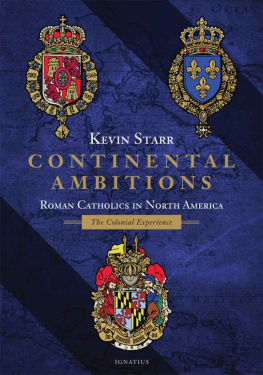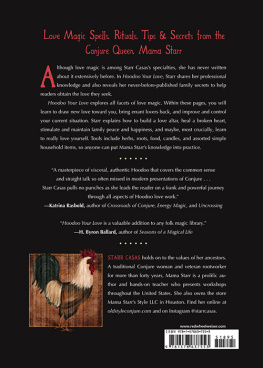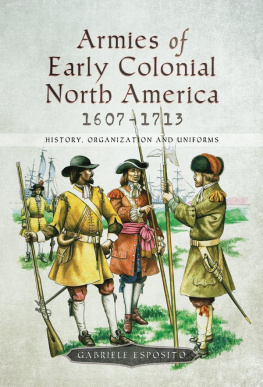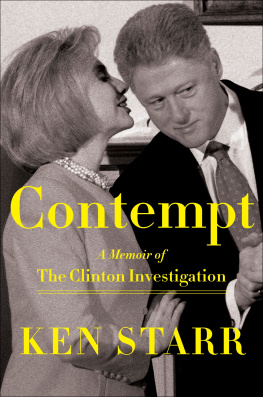CONTINENTAL AMBITIONS
KEVIN STARR
CONTINENTAL
AMBITIONS
Roman Catholics in North America
The Colonial Experience
IGNATIUS PRESS SAN FRANCISCO
English Scripture verses from the
Second Catholic Edition of the Revised Standard Version of the Bible
1965, 1966, and 2006 by the Division of Christian Education of the
National Council of the Churches of Christ in the United States of America.
All rights reserved.
Cover illustrations by Matthew Alderman
Cover design by John Herreid
Published in 2016 by Ignatius Press, San Francisco
2016 by Kevin Starr
All rights reserved
ISBN 978-1-62164-118-6 (HB)
ISBN 978-1-68149-736-5 (EB)
Library of Congress Control Number 2016933905
Printed in the United States of America
For Sheila Gordon Starr,
research companion and editor,
who never lost faith in this book
CONTENTS
Bishop Eric Gnupson arrives in Greenland as Scandinavians advance Christianity across the North Atlantic
Resistance grows against the genocide and enslavement of indigenous peoples
Dreams of empire mingle with evangelical ambition
Evangelization falters amid violence, slavery, and revolt
Friars and soldiers hold the Florida frontier
New Mexico, anchor kingdom of the Borderlands, begins with a massacre
Texas is organized as a buffer province
The Society of Jesus gains and loses its Pacific domain
New Spain launches an entrada into Alta California
New Spain secures a strategic harbor on the Pacific coast
Secularization brings a bishop to the Californias
Humanism inspires the foundation of New France
The Counter-Reformation and Catholic Revival take hold in New France
Dvots found a city on the far frontier
Iroquois destroy Huronia and threaten the survival of New France
The secret consecration of a vicar apostolic for Quebec brings Roman Catholicism to new maturity
A Jesuit savant reconnoiters French North America
The Mississippi Valley and Louisiana are explored and evangelized
A king and a peer lose their colonies
Catholic settlement spreads through the Chesapeake region
Catholic Maryland seeks education abroad while Philadelphia prefigures an American Catholic future
PREFACE
In the early modern era and throughout the eighteenth century, Spain, France, and England sought with mixed results to colonize and evangelize the North American continent. These ambitions involved heroic feats of exploration and invasive conquest, followed by efforts to establish settlements and missions that frequently met the resistance of indigenous peoples. Ironicallygiven the hostility, violence, and social disruption accompanying missionary endeavorsthe evangelization of indigenous peoples remains the aspiration most praised by Roman Catholic historians prior to recent times. True, in many cases, Spains colonizing effortsespecially in early years but later in Alta California as wellincluded deliberate acts of warfare, rapine, and massacre and led to the destabilization of local cultures and the destruction of native peoples health due to imported diseases. But the worldly ambitions of Spain, France, and England, being carried out in the name of religion also brought to the North American continent European Catholics in search of a better life, along with indigenous peoples converted to Catholicism and Catholics of mixed racial heritage who came into being. Motivated by Catholic values and according to their faith and culture, great men and womenboth clerical and laydid their best to improve conditions for the indigenous peoples of the continent. Those who say they were mistaken in these ambitions are not only judging them from contemporary perspectives; they are also branding them as hypocritical in their own time.
This narrative, however, frequently chronicles behavior that would be considered both hypocritical and offensive in any time or place, given the professed beliefs of Catholic Christianityor the tenets of humane conduct by people of any tradition. The fact is, the arrival of Roman Catholic peoples in North America, starting with the Norse of a thousand years ago, brought with it terrible figures as well as admirable ones. Most of them, though, were simply men and women in extraordinary circumstances who struggled to behave well in the face of temptation and weakness.
Still, however mixed the motivations for settlement were, or however we judge the successes (or failures) of the efforts described in this volume, the institutional record is clear. Roman Catholicism has major standing in the North American story. In 1886 John Gilmary Shea justifiably opened The Catholic Church in Colonial Days the first installment of his pioneering four-volume history of Catholicism in the United Stateson a serene and confident note. The Catholic Church, Shea wrote, is the oldest organization in the United States, and the only one that has retained the same life and polity and forms through each succeeding age. Her history is interwoven in the whole fabric of the countrys annals.
Few, if any, contemporary historians of American Catholicism would open a similar history with the same confidence. Still, everything that Shea claimed of the Catholic Church in her American context remains true. Catholicism was the first form of Christianity to reach the Americas, and, as Shea pointed out in his preface, Catholic names dominate the region, Catholic missionaries evangelized its indigenous peoples, Catholic colonists developed its resources, and Catholic patriots established its republics in Latin America and Mexico and assisted in the creation of the provinces of Canada and the United States. And whereas in 1886 Shea could note that ten million of his fellow American citizens were Catholic, today a historian can cite seven times that number, fully a quarter of the population of the United States. A contemporary demographer analyzing present and future trends, moreover, might even claim that by some point in the mid- to late-twenty-first century half the population of the United States will describe itself, in one way or another, as CatholicAmericans for whom the narratives in this volume constitute a usable past.
The variability of degree just suggested underscores the differences between the sure assertions of John Gilmary Shea in 1886 and the troubled and chastened mood of Catholic people today in these United States. At its deepest theological level, so Catholicism teaches, the Church remains the Mystical Body of Christ in time and eternity; no human force, no sins of error or omission on the part of the hierarchy or the faithful, can prevail against this identity. But in addition to her transcendent and mystical nature, the Church (and no one is more aware of this than her members) is a human society, and hence liable to mistakes on the part of her nearly one and a quarter billion members across the planet.
Even the most cursory reading of Catholic and secular publications presents the challenges facing contemporary Catholicism on all continents, with the possible exception of Antarctica. It is self-indulgent for Catholics of the developed world to equate their issues and concerns with those of Catholics in developing countries, who struggle daily to obtain food and water; in certain places in the Middle East and Africa, they confront the threat of genocide. Still, Catholicism is anchored in the doctrine of the Incarnation: the belief, as the prologue to the Gospel according to Saint John puts it, that the Word became flesh and dwelled among us. Catholicism teaches that Jesus Christ was both God and man. He ate and drank in the company of outcasts and sinners, and sat with Mary in the cool of the evening in the home she shared with her sister and brother, discussing the things of God. Catholics tend to stay close to history and the sacramental specifics of everyday life. As the English Jesuit poet Gerard Manley Hopkins writes, The world is charged with the grandeur of God. The world is our only pathway to salvation, provided we renounce its false promises. Catholicism, then, is enmeshed in and dependent on culture and society. It blesses through physical thingswater, oil, incense, beeswax candles, palm branches. Its central and unifying rites, baptism and the Eucharist, are dependent on water, bread, and wine. It anoints its infants, teenagers, clergy, and dying with oil. Catholicism prizes art, architecture, and music as windows on divinity. It values community, sacred and secular and admixtures thereof, as well as the principle of subsidiarity: keeping things as local as possible. Catholicism considers itself an essential component of human life and society and the history that is being forged.
Next page





